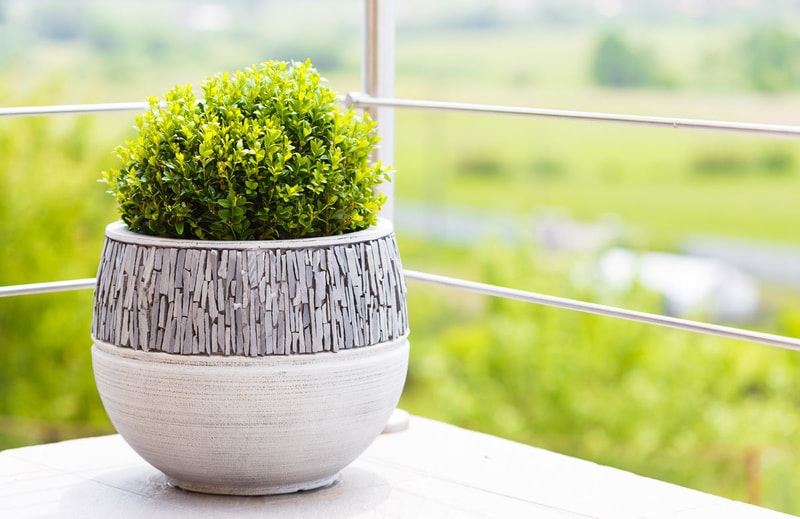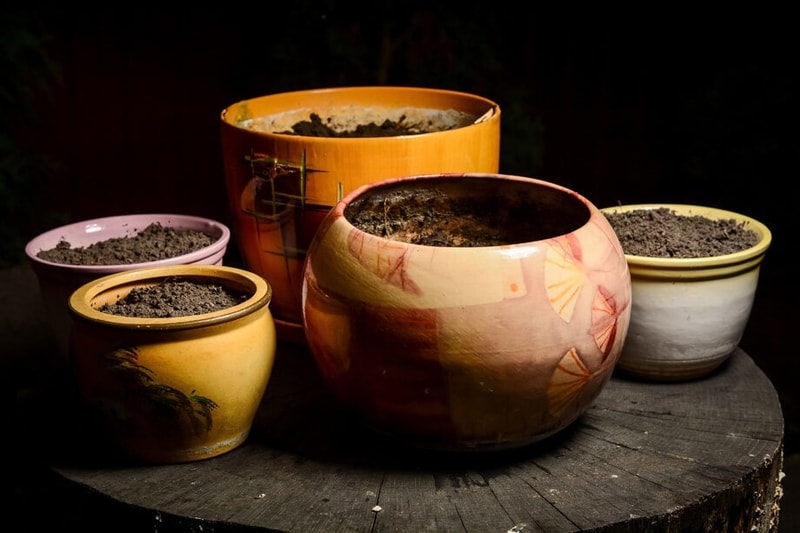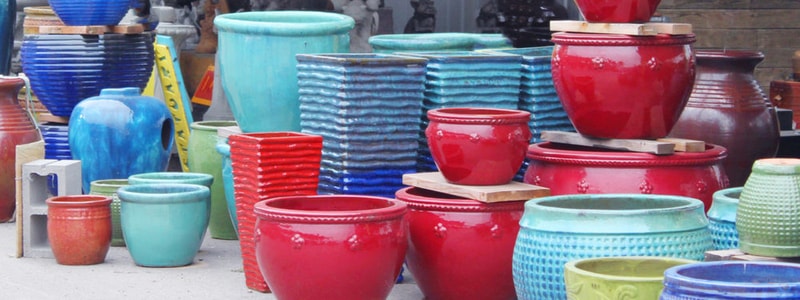In this article we’ll talk about planters, especially focusing on the ones made from ceramics since they’re very popular options, however they also have their drawbacks, which is why we’ll compare them to some of the other popular materials that you can find when you go to places like Home Depot.

What is a Planter and What Purpose Do They Serve?
The planter, as you might have guessed is a great place for you to add those plants into that you are so meticulously taking care of, but it doesn’t just have a functional purpose. They’re also typically made for their decorative properties and can either be placed inside or outside too depending on where you want to store them.
They are available in different materials, and one style may be better suited for your home than another. While this article will focus especially on the ceramic ones, we’ll also be talking about the other options available to you, not just in terms of material but also in terms of style and how to best make it fit with your lifestyle.
If you’re living in a small apartment, you naturally won’t be able to install a massive ceramic planter without sacrificing very valuable space, so if that’s the case, you will naturally want to make sure that the plants and corresponding container are the best possible choice for you.
There are also instances where the ceramic planters might not be your best option, and we’ll talk about that too.
Choosing the Right Size and Type for Your Project

It’s always an important consideration to actually consider the location you’ll be putting it in. If it’s going inside, not everyone might be equally happy about placing a concrete structure there that can just seem very visually invasive.
The different materials also come with different price tags. You can get both ceramic ones that are very cheap, but if your budget allows it, there are really beautiful high-end ones too, and the price tag will reflect it.
Perhaps the most important consideration is how big the container should be, and that will be determined by what you’re planting in it. You should make sure not to plant things that require a significantly bigger container than what it is you’re planning on getting. Traditionally, plants will prefer more space, which is better in terms of not limiting root growth.
there’s a mixture of options available being imported from a mixture of countries including Vietnam, Malaysia and China, and if you go to a store to pick them up, they’ll be able to tell you if they can withstand frost or not.
When you’re getting a really big planter, it will also draw a lot of attention in a garden, and it’s therefore not a choice you can make without taking into consideration the other things in the garden. When you’re remodeling your home, you’re also aiming to do it in a way that complements all your other decisions in your home so that the project increases the resale value of your property. While you can choose something that adds contrast, it shouldn’t be that it looks ugly next to your other garden features.
If you’re buying a planter that will be standing there all year, you should also remember that the colors will be changing with the seasons, and that could influence your decision.
For the size of the container, you should be thinking about what you’ll be planting in it and whether you wish to keep your opportunities open to plant bigger things in it at a later stage. A planter with no drainage hole can cause root rot, whereas still-standing water is an easy way to invite the mosquitoes to visit you, which isn’t fun either. By the way, here’s a guide on getting rid of mosquitoes if that’s a problem in your home.
There are also a lot of plants that don’t require the pot to be completely full of soil, and when combined with things such as mulch instead, you’re making the planter lighter and more easy to move, and it also helps in terms of drainage.
Type of Planters
Ceramic isn’t the only type of planter for you to choose from, in fact there are both a lot of different materials and styles, some of them which we will go through in this article. Some homeowners swear by one over another, and it will depend on how highly you value the different factors, which recommendation we would make to you.
Plastic
Let’s start out by looking at another popular alternative – plastic. This is often the second option that people will go to, but yet you’ll also find homeowners that would never voluntarily choose this for their plants.
Let’s look at how the materials compare. At the end of the day, you’ll need to also consider the type of plant you’ll be planting. Your needs will inevitably be different if you’re doing vegetable gardening in them than if you’re simply doing it for decorative purposes.
Different plants have different needs when it comes to moisture, which in turn should affect the frequency of your watering, if you’re not letting mother nature handle for you.
Unglazed ceramic has an advantage and that is that it’s porous. What that means is that it’ll be easier for it to shed excess water, and this choice can therefore be an advantage if it rains a lot and you aren’t too sure if the drainage if sufficiently good. When you get these, you should also more carefully watch the moisture level in the container so that it doesn’t become too dry in periods without a lot of rain, and remember to water at those points too. Roots will also have an easier time growing in unglazed ceramics.
You should beware that while this is the case with the unglazed material, the glazed one won’t have the same advantages, and these have a lot of the same features as plastic ones in the fact that they’ll keep moisture longer and the air circulation will be worse too. If you have plants that require a lot of water, and you’re not very good at making sure to water them, then you can probably guess what our recommendation is.

Plastic does have a bunch of advantages, including being lighter, which also makes them easier to move. There’s a bunch of different styles available, however, they can also end up simply feeling too ‘plasticky’, which is not a look desired by everyone. With it you get two other important advantages being that they have a lower price tag and they’re also more difficult to break. Bump clay against something in an accidental manner, and you might no longer have one piece of clay, but rather two – yes, it can break upon impact. Plastic doesn’t chip either, and while glazed ceramic doesn’t easily get stained, unglazed ceramic could get stained.
The additional weihgt of clay makes them more stable, but harder to move, and once you start getting big ones, they’ll weigh a considerable amount and weight could become a determining factor if you’re expecting harsh winters. Since clay’s thicker, it helps keep the container warm for longer, which could prove important for the root system.
The plastic pots will usually have a limited lifespan, but they don’t leave sharp edges if they crack and they can therefore also be considered the more childproof option. n the other hand, they’re also likely to change color when exposed to direct sunlight for extended periods of time. It’s generally a good idea to avoid plastic when you’re going to grow edible things in it because certain types of plastic could leak nasty things into the vegetables.
Metal
A lot of the different metal materials made for planters have the downside that rust is a concern you might have to deal with. There’s often a plastic liner so that the rust stays out of the planter.
Corten Steel Planters
Corten steel is in fact rusted metal, and they will definitely visually add to your garden when matched properly. In fact, corten steel is also used for siding, but you might want to be cautious since the material has been known to leave rust marks after it has rained, and you may therefore wish to consider where you place the container.
Wood
As well as wood siding, the material is also commonly used for planters. The disadvantage with the material is that it will usually stand a tough time against the elements if simply left outside untreated for extended periods of time. For instance, cedar siding needs staining every 2-3 years to keep it protected, and the wood that is used for a planter is no different. If left untreated, it’s prone to rotting over time. There’s often a liner added on the inside to help protect the material from the otherwise constant moist exposure from the soil.
Stone
While stone is beautiful, it’s also a porous material, and that means that it can easily start changing color over time as a consequence. They’re also incredibly heavy.
Fiberglass
Being a more expensive option than plastic, they do however have some advantages in that they’re more durable and won’t start losing their color nearly as fast either. They commonly resemble other materials too and are light-weight which is an advantage when you wish to move them.
All Weather Planters – Freeze-Proof Planters that You Can Leave Outside Year Round
Remember that we said there might be circumstances when you will want to avoid ceramic planters? Well, there’s a reason for it. They’re not the ideal choice for all scenarios because they have the vulnerability of being porous, means they’ll absorb a certain amount of water if they haven’t been glazed.
What that means is that the water that is now inside the pores freezes when it’s cold, and freezing water expands. With it, you will very likely see your planter not making it through the winter.
The good news is that you can also get porcelain ones that in theory should be able to withstand the harsh elements which is what frost is. The reason we say should is because there are a lot of times when ceramic has been mislabeled as porcelain, and it doesn’t actually have the advantageous properties that come with choosing this option, which tends to also be more expensive.
To better understand the differences between porcelain and ceramic, we urge you to read the article that is linked to within that sentence. We’ve also written extensively on the topics of ceramics floors and porcelain floors, which are also articles that you might find interesting.
Basically, to summarize the differences between the two materials, it comes down to the materials ability to withstand water and exposure to it, with porcelain’s ability being better. What that means is that the material needs to have a water absorption rate below 0.5% to actually be considered porcelain.
Still, why are you saying that the porcelain planters should be able to withstand frost and not that they are in fact able to do so?
The reason why we’re cautious in our wording is that it is often mislabeled. Porcelain is not a protected title, and a lot of the imported stuff especially does not have the properties that it requires to be deemed porcelain according to the US standard groups, so you could end up with a planter that absorbs more water than it should be, if it actually was the right material, and then it cracks in the cold.
If you actually get porcelain, they should be sufficiently water-resistant to be able to be placed outside year-round. When in doubt, ask the seller if it’s the case or not.
There are, however, material that we have previously mentioned that can be used year-round, even if it freezes. Do remember that it’s not even all plants that will be able to withstand the cold whether, but at least the container will. Therefore make sure that it’s not just the container but also the plants itself that is frost-proof. If you don’t mind having to move the container inside during the winter, or when you expect the first frost to hit, ceramic is definitely a potentially beautiful option.
It wouldn’t be fun if you go out onto your deck or patio simply to find out that the containers didn’t make it through the night. The best potters that can withstand the frost include fiberglass, wood and plastic. Metal is usually also able to live through it, but you will want to pay close attention to them and ensure that there’s no sign of rust. Galvanized ones have better protection against this, but it’s always a good idea to look out, just in case.
Ceramic is actually not the only type of planter that will often suffer in the cold. Terra cotta and concrete are also materials that will need to be taken inside if they haven’t had sealants applied to them, or you might soon find them cracking. It’s the same reason why concrete driveways need repairs. The water will seep into the small cracks and expand as it freezes. When it thaws, it once again leaves space for more water, and after repeated freeze and thaw cycles, you’ll see the holes getting bigger and bigger as a consequence.
